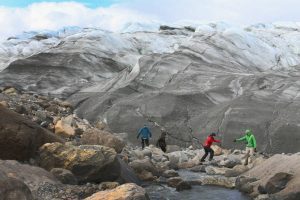

Scientists are exploring changes underway in the Greenland Ice Sheet as a result of global warming. (Credit: Joe Raedle/Getty Images)
In the high-stakes race against sea level rise, understanding what’s causing the Greenland Ice Sheet to melt is critical. The problem isn’t just rising temperatures: soot from ships, wildfires and distant power plants, as well as dust and a living carpet of microbes on the surface of the ice, are all speeding up the melting.
Right now, predictions for sea level rise range from about 1 to 10 feet by 2100—a wide difference for coastal communities trying to plan seawalls and other protective measures. The more we understand about how pollutants affect the ice, the more accurate those projections will be.
Click here for more information.